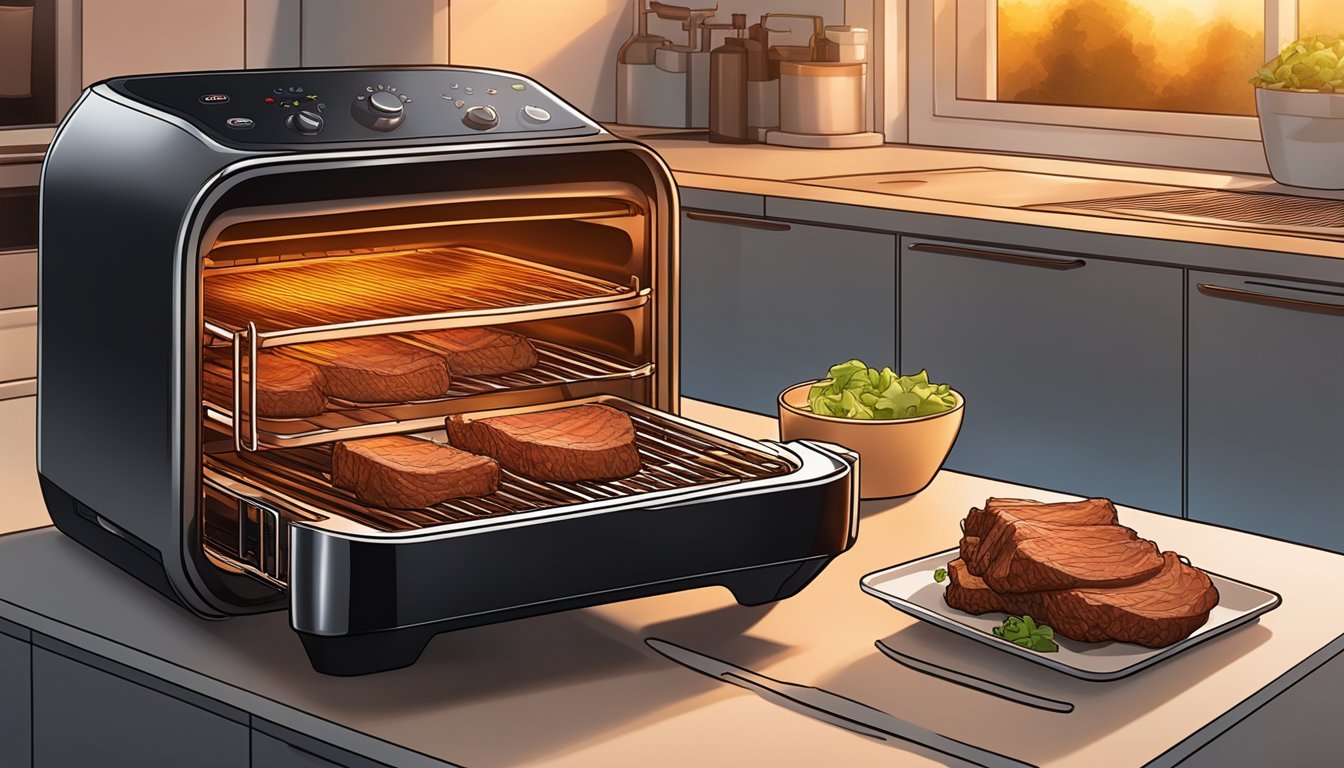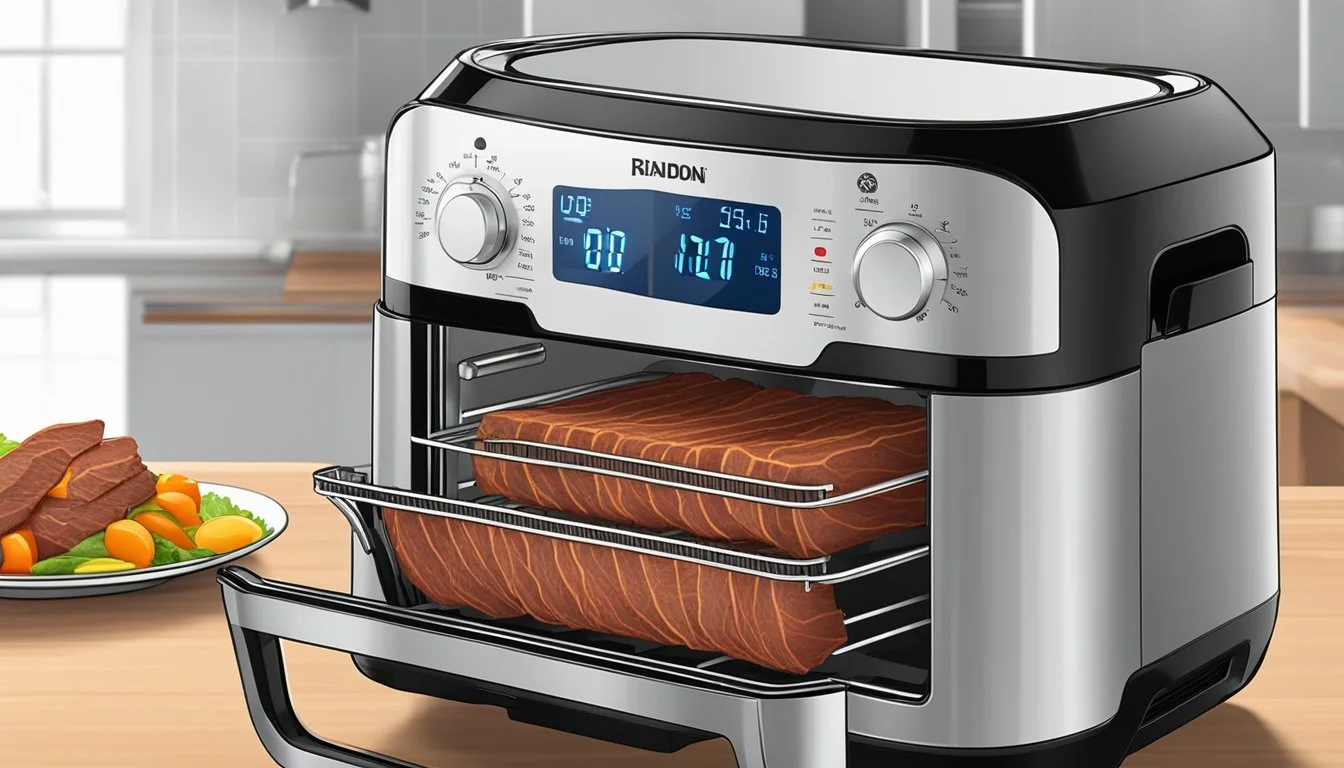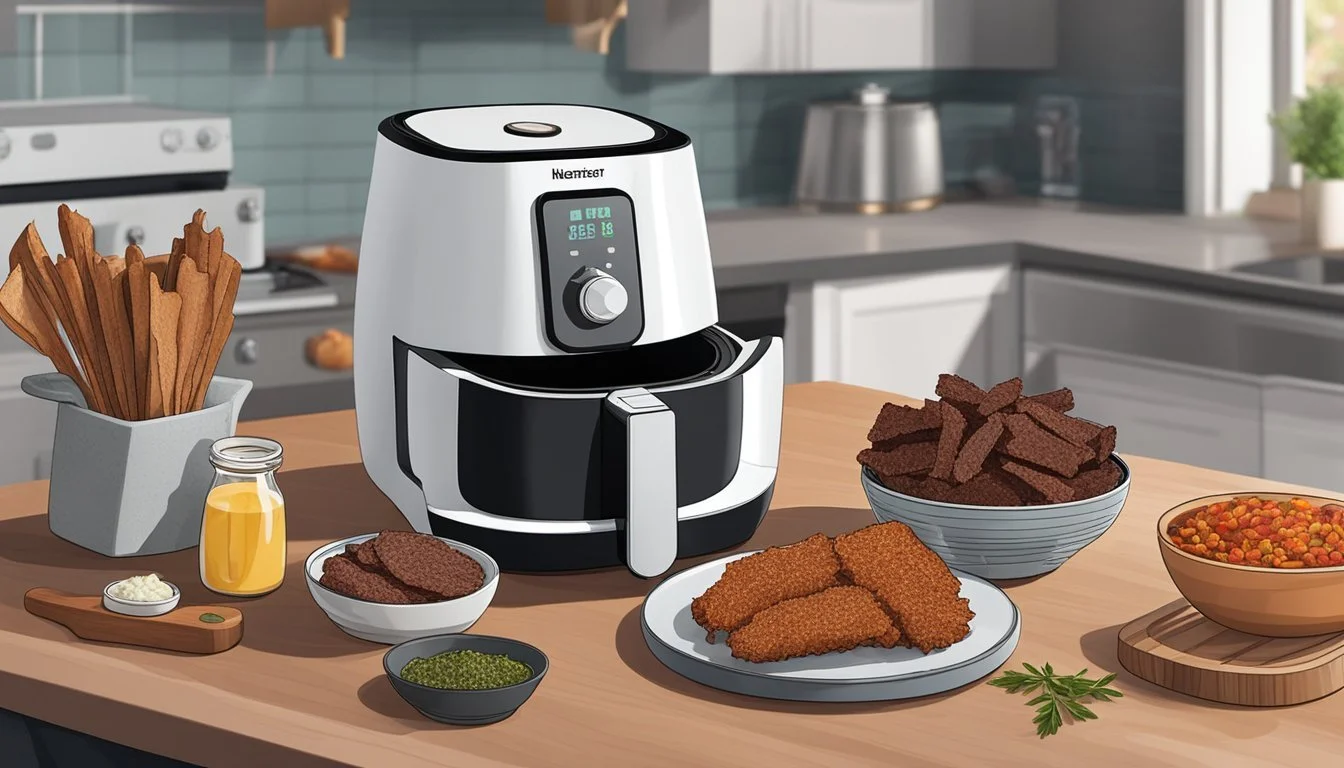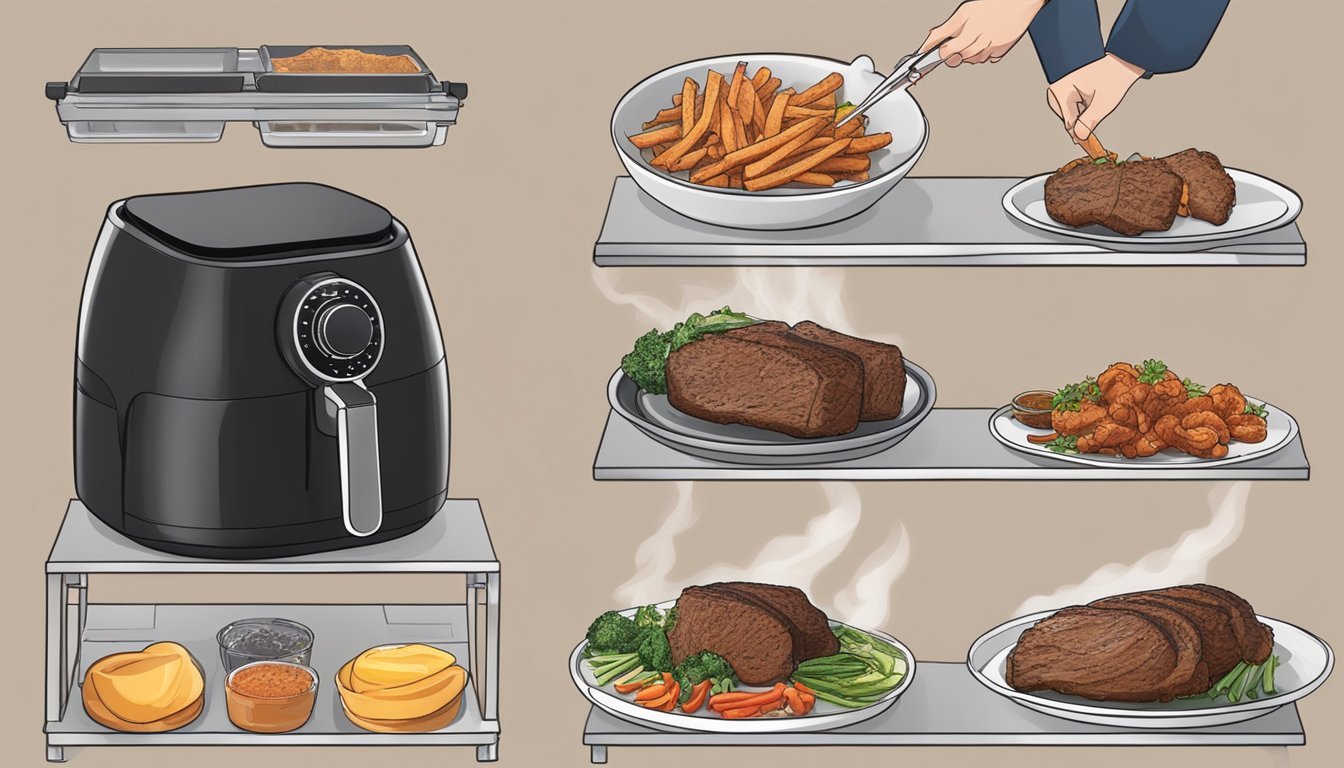Air Fryer Beef Jerky
Homemade Snacking Made Easy
The rise of home cooking innovations has graced kitchen countertops with the air fryer, a versatile appliance that excels in creating healthier versions of beloved snacks. One such snack, beef (What wine goes well with beef?) jerky, traditionally made through a slow drying process to preserve meat, is being rediscovered by enthusiasts who prefer a homemade touch. Preparing beef jerky at home allows for complete control over ingredients, seasoning, and texture, ensuring a custom snacking experience tailored to individual tastes.
Air fryers employ rapidly circulating hot air to cook foods, which results in a quicker dehydration process essential for making beef jerky. This method not only speeds up the creation of this protein-rich snack but also does so with reduced energy consumption compared to conventional dehydrators or ovens. Homemade beef jerky in the air fryer captures the essence of this timeless snack with the added benefits of convenience and personalization.
As consumers become more involved in their dietary choices, making beef jerky at home with an air fryer offers a straightforward and satisfactory process. It taps into the desire for high-quality, preservative-free snacking options. With the ability to adjust flavors and the level of dryness, homemade beef jerky stands out as a practical and pleasurable pursuit for those seeking to integrate hands-on methods into their snacking habits.
Essential Ingredients for Beef Jerky
Creating beef jerky requires a thoughtful selection of meat and seasonings to ensure a delicious and healthy snack. Paying attention to the cut of beef, the marinade ingredients, and their nutritional content is key for the best outcome.
Choosing the Right Beef Cut
For beef jerky, lean cuts are preferred due to their low fat content, which ensures a longer shelf life and better texture. Top round, bottom round, eye of round, and sirloin tip are excellent choices for jerky. They're economical and hold up well during the drying process. Flank steak and sirloin are other options, but they can be pricier. When preparing the meat, it's important to slice the beef thinly against the grain to achieve the perfect chewy texture that jerky is known for.
Flavoring with Marinades and Seasonings
The flavor of beef jerky comes from the marinade and seasonings used. A traditional marinade includes items like:
Soy sauce or tamari for a salty, umami flavor.
Worcestershire sauce to add complexity.
Sweeteners such as sugar, brown sugar, or honey.
Garlic powder, onion powder, and black pepper for a savory kick.
Smoked paprika, liquid smoke, or even teriyaki sauce for a smoky or Asian profile.
To spice things up, options include chili flakes, crushed red pepper, or cayenne pepper.
The marinade should coat the thin strips of beef thoroughly and be left to soak in the flavors for at least four hours or ideally, overnight.
Balancing Health and Taste
Beef jerky can be a good source of protein and iron with relatively low levels of carbohydrates and saturated fat. By using homemade marinades, control over calories, sodium, and added sugars is possible, thus maintaining the balance between health and taste. Opting for natural sweeteners and using less sodium-heavy sauces are ways to keep jerky both flavorful and healthy. Monitoring ingredients like honey or liquid smoke can help adjust the flavor profile without significantly compromising the nutritional value.
Preparation Steps
The preparation of beef jerky in an air fryer begins with careful trimming and slicing of the beef, followed by crafting a well-balanced marinade for flavor infusion. These crucial steps lay the groundwork for delicious, homemade jerky.
Trimming Fat and Slicing Beef
One must start by selecting a lean cut of beef; popular choices include top round or flank steak. Prior to slicing, the fat must be trimmed off meticulously, as fat does not dehydrate well and could cause the jerky to spoil more quickly. It is recommended that the beef be partly frozen to enable easier, more consistent slicing.
Thickness: Ideally, slices should be uniform and about 1/8 to 1/4 inch thick.
Grain: Slicing against the grain results in jerky that is easier to chew, while slicing with the grain gives a more traditional, tougher chew.
Creating the Perfect Marinade
A marinade serves two purposes: it infuses the beef with flavor and it can tenderize. The marinade typically consists of various ingredients that create a flavorful and umami-rich profile.
Ingredients for Marinade:
Soy sauce or coconut aminos: Provides the base and contributes to the umami flavor.
Apple cider vinegar: Adds acidity for balance and tenderization.
Seasonings: Such as smoked paprika, garlic powder, onion powder, and salt.
Here’s a simplified process:
Combine all the marinade ingredients in a bowl.
Add the sliced beef to the mixture, ensuring each piece is well-coated.
Marinate: Cover and refrigerate the beef, typically for at least a few hours up to 48 hours, enabling the flavors to deeply penetrate the meat.
Marinating Process
The marination phase is crucial for creating flavorful beef jerky, where the meat has adequate time to absorb the spices and seasonings used in the marinade.
Marinating Time and Techniques
A minimum of 4 hours is necessary for marinating the beef, but ideally, the meat should be left in the refrigerator to marinate overnight. This prolonged exposure ensures that the flavors deeply penetrate the beef, creating a rich and robust taste. The technique involves placing the beef in a resealable bag or container with the marinade and ensuring every slice is well-coated. To achieve evenly flavored jerky, one might massage the marinade into the meat, then let it rest in the refrigerator, which serves as the optimal environment for the marinating process.
Prep Time: At least 4 hours to overnight
Location: Refrigerator
Method: Ensuring even coating and massaging marinade
Enhancing Beef Jerky Flavor
Marinades are the secret to elevating the taste of beef jerky from plain to extraordinary. A variety of marinades can be crafted, either spicy or savory. Spicy jerky enthusiasts might incorporate ingredients such as cayenne pepper, chili flakes, or hot sauce. For a savory note, ingredients like Worcestershire sauce, soy sauce, or liquid smoke are favored. Fresh herbs, garlic, and warm spices can also be used to diversify the seasoning profile.
Spicy Jerky: Cayenne, chili flakes, hot sauce
Savory Jerky: Worcestershire, soy sauce, liquid smoke
Seasoning: Herbs, garlic, spices
It's important to drain off the excess marinade and pat the beef dry before proceeding to the drying stage. The attention to detail during the marinating process sets the stage for high-quality, homemade beef jerky.
Air Frying Techniques
The air fryer offers a convenient method to make beef jerky at home, using the principles of rapid air circulation and precise temperature control to dehydrate the meat efficiently and safely.
Preparing the Air Fryer
Before beginning the cooking process, the air fryer needs to be prepped to ensure optimal cooking conditions. Start by preheating the air fryer, as this helps to create a consistent cooking environment from the start. The Cosori Air Fryer is a popular choice and, like most models, features a preheating function. It's vital to ensure the air fryer basket is clean and accessible for easy placement of the beef strips.
Air Frying Beef Jerky
Once the air fryer is preheated, place the beef strips in a single layer within the air fryer basket to ensure even air circulation and consistent dehydration. Temperature is critical for making jerky: a lower setting, ranging from 165°F to 180°F, is commonly recommended. This helps in slowly dehydrating the meat while keeping it tender. Set the cook time according to the thickness of the strips; typically, beef jerky takes between 1 to 4 hours to dehydrate effectively.
Monitoring for Doneness
Throughout the total cooking time, monitor the jerky for doneness. The exact timing can vary based on the air fryer model and the thickness of the beef. Air frying adds convenience to the process, but attention is still required. The jerky should have a leathery texture when properly dehydrated and be devoid of any moisture. The internal temperature of the jerky should reach at least 160°F to ensure safety.
Post-Cooking Procedures
Once beef jerky is cooked in an air fryer, it is important that it is handled correctly to ensure safety and quality. The cooling and storage process is crucial to maintain the jerky's flavor, texture, and nutritional value.
Cooling and Storage Tips
After the beef jerky is air-fried, it should be allowed to cool at room temperature before storage. This prevents condensation that could lead to moisture buildup, which is a breeding ground for bacteria. Storing the beef jerky properly extends its shelf life. Here is a concise guide:
Room Temperature: Once cooled, homemade beef jerky can be stored in an airtight container for up to 2 weeks.
Refrigerator: For longer storage, place the jerky in a sealed container and keep it in the refrigerator where it can last 1 to 2 months.
Freezer: For the longest shelf life, beef jerky can be frozen. In an airtight container or freezer bag, jerky will stay good for up to 6 months. Defrost in the refrigerator before consuming.
Nutritional Information and Serving
Beef jerky is a high-protein, low-carb snack that can be part of a healthy diet in moderation. Homemade jerky made in an air fryer can be less greasy and free from preservatives. Here's a snapshot of the typical nutritional profile for a single serving of homemade beef jerky:
Nutrient Amount per serving Calories Varies Protein 9g Fat Varies Carbohydrates 3g Vitamin C 0% Daily Value
Bear in mind that exact nutritional information can vary based on the cut of beef used and the marinade ingredients. Always check for specific nutritional content if the beef jerky will be part of a dietary regimen.
Additional Tips and Tricks
When making homemade beef jerky in an air fryer, chefs and food enthusiasts can achieve the most flavorful results by paying attention to preparation techniques and cooking processes. Below are several tips and tricks to enhance the quality of homemade jerky.
Marination: The key to flavorful jerky lies in the marination. Ensure that the beef is thoroughly coated and allow it to marinate in the refrigerator for at least 4 hours, although overnight is better for deeper flavor penetration.
Drying Before Cooking: After marination, it is essential to pat the beef dry. This step is crucial as it helps to achieve that characteristic jerky texture by removing excess moisture.
Arrange Properly: To ensure even cooking, arrange beef slices in a single layer in the air fryer basket with space between them. Overlapping can lead to unevenly cooked jerky.
Temperature: Set the air fryer to the recommended temperature, usually between 160°F to 180°F, to efficiently dehydrate the meat without overcooking.
Flipping: For consistency in texture, flip the beef strips halfway through the cooking process. This helps in evenly drying out the beef from both sides.
Checking for Doneness: Homemade jerky's perfect texture is leathery but still chewable. Begin checking after the first hour of cooking and frequently thereafter to prevent over-drying.
Storage: Once cooked and cooled, store the jerky in an airtight container to maintain its freshness. A properly sealed container can also keep the jerky safe for consumption over a longer period.
By deploying these tactics, individuals are more likely to enjoy success in their homemade jerky endeavors, turning out delicious and safe snacks that can be enjoyed over time.
Troubleshooting and FAQs
What beef cuts are best for jerky in an air fryer? Beef with minimal fat, like eye of round or flank steak, works best for jerky. They should be sliced against the grain for optimal texture.
Why isn't my beef jerky drying properly in the air fryer? Jerky may not dry properly if the slices overlap. Ensure they are laid out in a single layer and the air fryer is not overcrowded.
Common Issues with Air Fryer Beef Jerky:
Overcrowding: Causes uneven drying.
Too Thick Slices: May result in chewy jerky.
Fluctuating Temperatures: Stick to a constant low temperature for even drying.
Problem Possible Solution Jerky is too tough Slice the meat thinner or reduce cooking time. Jerky is not drying Check air fryer temperature and ensure it’s set correctly. Jerky burnt on edges Reduce temperature or cooking time.
How long does beef jerky take to cook in an air fryer? Cooking time ranges from 3 to 4 hours at 165°F (74°C), depending on thickness. Check periodically for desired doneness.
Can I use fresh beef for air fryer jerky? Yes, fresh beef is ideal. Ensure it’s properly trimmed of fat and marinated for at least 4 hours for flavor and tenderness.
Do I need to preheat the air fryer? Yes, preheating to the recommended temperature ensures even cooking from the start.
Remember consistency is key for perfect beef jerky in an air fryer. Monitor during cooking and be prepared to adjust as needed.
Conclusion
Making beef jerky at home with an air fryer combines traditional dehydrating techniques with modern convenience. The air fryer's efficient circulation of hot air allows for a controlled and even dehydration process, which is crucial in creating the perfect jerky.
Key Points to Remember:
Marinades and Seasonings: Personalize the beef jerky with various seasonings and marinades. The potency of flavors in homemade jerky surpasses that of store-bought versions.
Dehydrating: Achieving the quintessential texture of beef jerky depends on proper dehydration. Monitor the jerky during the air frying process to prevent overcooking.
Air Frying Time: Depending on the air fryer model, cooking times may range from 1 to 4 hours. It's essential to adjust temperatures based on specific equipment and desired doneness.
Homemade beef jerky is a healthier alternative, free from the preservatives and additives often found in commercial products. They gain control over the quality of the beef and the ingredients used, tailoring the recipe to suit personal dietary needs and taste preferences.
In summary, air fryer beef jerky offers a practical approach to snacking, combining ease-of-use with customizable taste experiences. It compels them to experiment with recipes and enjoy a hands-on approach to crafting delicious, protein-rich jerky.






